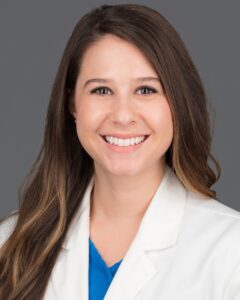Nutrition Considerations for an Aging Population
Megan Uribe, PA-C
PA Foundation Nutrition Outreach Fellow
July 31, 2023

In our training for the 2022-23 Nutrition Outreach Fellowship, our cohort of PA Fellows focused on nutrition recommendations for healthy aging, diabetes, and wound healing. This information, particularly nutrition for an aging population, has been remarkably helpful in my practice of medical oncology. According to the Population Reference Bureau, the number of people aged 65 and older in the United States is projected to more than double by 2060, from 46 million to more than 98 million – one quarter of the American population.2 The rapid growth of our aging population puts an increased demand on our healthcare system, including in-home caregiving and assisted living facilities. It is important to identify risk factors for unhealthy aging early, before diseases of aging become prevalent. As PAs, we can accomplish this by making routine nutrition screenings part of our regular practice.
We know that today’s common comorbidities, such as hypertension, arthritis, heart disease, cancer, and diabetes, are generally diseases of excess – excess calories, excess processed foods, and excess sugars. This differs from 100 years ago, when the most common diseases were diseases of deficiency, including rickets (vitamin D deficiency), scurvy (vitamin C deficiency), beriberi (thiamine/B1 deficiency), and pellagra (niacin/B3 deficiency). Luckily, we also know that most of these modern-day comorbidities can be managed with lifestyle modifications like diet and exercise. According to the Diabetes Prevention Program Research Group, losing 5-7% of body weight and adding 150 minutes of weekly exercise can reduce a person’s risk of developing type 2 diabetes by 58%.3 That translates into as little as a 10-pound weight loss for a 200-pound person. Considering that diabetes is the sixth leading cause of death overall in the U.S., this is a small but extremely important lifestyle modification that can help our patients age as healthily as possible. The benefits of these lifestyle modifications can also be applied to helping to prevent or treat other chronic diseases, like hypertension and heart disease.
Risk factors for unhealthy aging can’t just be limited to things in “excess.” For example, in my medical oncology practice, mostly comprised of elderly patients, I see the exact opposite. Many of my patients are deficient in calories, protein, essential vitamins, and physical activity. This is due to a combination of side effects from cancer treatments in addition to expected side effects of aging. As we age, our dietary needs change significantly. In general, most people become less active and their metabolism slows, meaning they require less food. Additionally, a person’s ability to absorb and utilize micro- and macronutrients becomes less efficient, meaning their nutrient requirements actually increase. Confusing, right? This means that in order to counterbalance decreasing energy requirements, older people should be eating a healthier diet but not necessarily eating more – essentially, quality over quantity. Focus should largely be put on eating more whole foods and less processed foods. This can be complicated by common effects of aging, like cognitive changes, loss of appetite, changes in taste and smell, physical immobility, and loss of teeth. Aging patients may also be limited by factors like lack of access to food because of driving restrictions, lack of social support, and a limited budget.
I propose a few suggestions to help our aging population ensure they are meeting nutrition requirements. First, it is vital to start nutrition screenings early and to screen often, ideally identifying nutrition-related issues before a diagnosis of a chronic condition. I also suggest becoming familiar with resources in your community that are available to patients. Meals on Wheels is an excellent resource available nationwide for elderly patients who find it difficult to leave their home or cannot prepare their own meals. People of all incomes and ages are eligible. Other great resources are community food pantries. I have been volunteering at the Feeding Tampa Bay Community Pantry, a local organization offering access to free food to people in the community, regardless of income. The pantry offers a specific day reserved for elderly patients to shop. In my experience, people come into the pantry and “shop” just like they would at a standard grocery store. There is typically a vast selection of produce and pantry items. Depending on availability, patrons are allowed to take home as much produce as they want.
There is much we can do to improve nutrition for our aging population in the U.S. We need more studies specifically focused on elderly patients and nutrition, as most currently available studies are focused on a younger population. In addition, we as providers should be focusing more of our discussions with patients on dietary habits as a means of disease prevention. And when in doubt, refer to a registered dietician!
References
- Institute of Medicine (US) Food Forum. Providing Healthy and Safe Foods As We Age: Workshop Summary. Washington (DC): National Academies Press (US); 2010. 5, Nutrition Concerns for Aging Populations.Available from: https://www.ncbi.nlm.nih.gov/books/NBK51837/
- Mark Mather, Linda A. Jacobsen, and Kelvin M. Pollard, “Aging in the United States,” Population Bulletin 70, no. 2 (2015), www.prb.org.
- Diabetes Prevention Program Research Group, Knowler WC, Fowler SE, Hamman RF, Christophi CA, Hoffman HJ, Brenneman AT, Brown-Friday JO, Goldberg R, Venditti E, Nathan DM. 10-year follow-up of diabetes incidence and weight loss in the Diabetes Prevention Program Outcomes Study. Lancet. 2009;374(9702):1677-86. doi: 10.1016/S0140-6736(09)61457-4. Epub 2009 Oct 29. https://www.ncbi.nlm.nih.gov/pmc/articles/PMC3135022/
- Susan B Roberts, Rachel E Silver, Sai Krupa Das, Roger A Fielding, Cheryl H Gilhooly, Paul F Jacques, Jennifer M Kelly, Joel B Mason, Nicola M McKeown, Meaghan A Reardon, Sheldon Rowan, Edward Saltzman, Barbara Shukitt-Hale, Caren E Smith, Allen A Taylor, Dayong Wu, Fang Fang Zhang, Karen Panetta, Sarah Booth, Healthy Aging—Nutrition Matters: Start Early and Screen Often, Advances in Nutrition, Volume 12, Issue 4, July 2021, Pages 1438–1448, https://doi.org/10.1093/advances/nmab032

